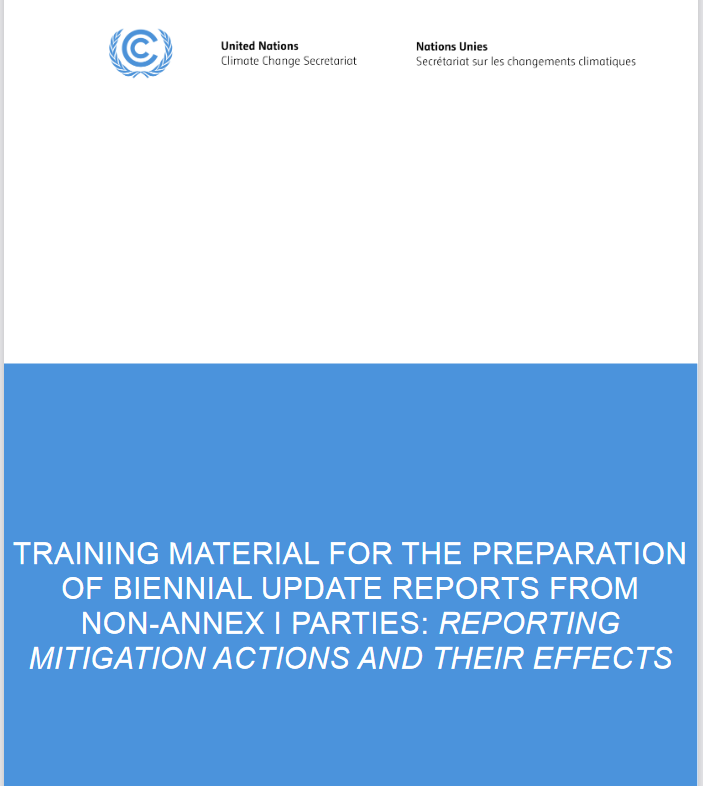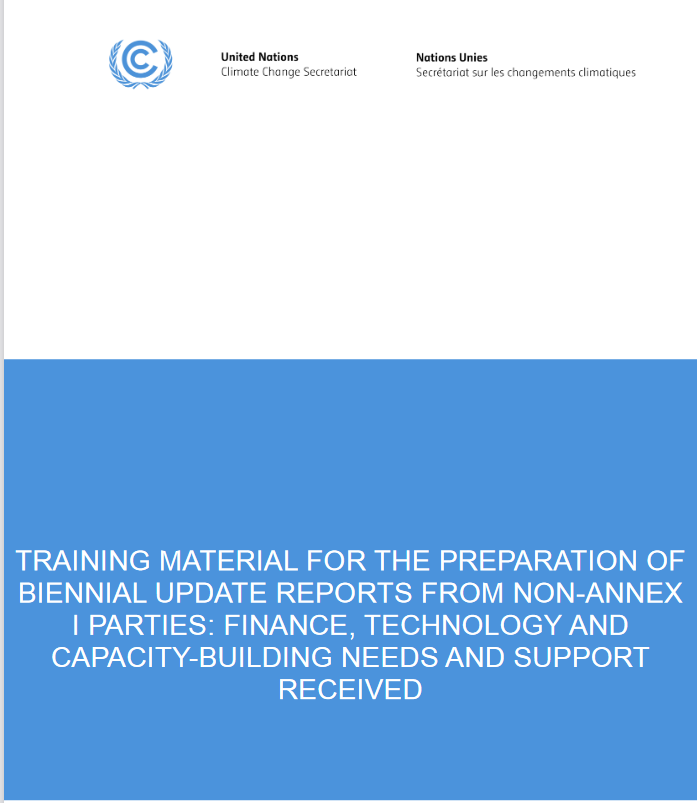1.0 Introduction
Hello again! This blog is a follow up to the one in which I shared that I am now writing a thesis as part fulfilment of an MSc degree in Climate Change, Agriculture and Food Security at the University of Galway – see www.nuigalway.ie/ccafs for a brief overview of the course. I am researching what constitutes institutional arrangements for Non-Annex 1 countries in the context of their UNFCCC and Paris Agreement commitments. To recap, countries, as part of their UNFCCC and Paris Agreement reporting requirements are expected to describe the institutional arrangements that they have established in order to carry out the climate change work they have committed to do, in two key reports that they are expected to submit. These reports are a National Communication report (NC) and a Biennial Update Report (BUR) for Non-annex 1 countries and a Biennial Report (BR) for Annex 1 countries. My last blog focused on describing what the NC report is all about. This blog will focus on what BUR and BR are about.
2.0 Annex 1 and Non- annex 1 countries have different reports to prepare
Did you know that, since 2014, Annex 11 countries are expected to submit a Biennial Report, (BR), and Non- Annex 12 countries a Biennial Update Report, (BUR), describing progress against their climate change commitments, and that reporting requirements will become more stringent in 2024?

The Biennial Update Report, (BUR) and Biennial Report (BR) are linked to the United National Framework Convention for Climate Change (UNFCCC) which was adopted by 197 parties and came into force in 1994.
Parties, i.e. member states, both Annex 1 and Non–Annex 1 countries are expected to submit their BR and BUR respective reports in order to meet their reporting requirements under the Convention, article 4 paragraph 1(a) and Article 12, which are about the communication of information related to the implementation of the convention.
In short, both BRs and BURs focus on providing an update of the progress presented in their National Communication (NC) report submitted to the Conference of Parties, (COP), but without necessarily including information on adaptation. See my blog on National Communication (NC) report setting out what should be included in NCs. A brief of what is expected in BURs and BRs is provided below.
Non-Annex 1 countries, consistent with their capabilities and the level of support provided for reporting, should submit their first BUR by December 2014, and every two years thereafter. However, according to the UNFCCC website, the least developed country parties and small island developing states may submit BURs at their own discretion, either as a summary of part of their National Communication Report in the year in which the National Communication Report is submitted or as a stand-alone update report.
Guidance for what should be included in a BUR is contained in decision 2/ CP.17, annex III, which was decided at the Conference of Parties (COP) 17.
Similarly, developed country parties were requested to submit their first Biennial Report (BR1) to the secretariat by 1st January 2014 and every two years thereafter. This could be submitted as a stand-alone report or as an annex to the National Communication (NC) in the year that NC is due. Guidance on what should be included is provided in decision 19/CP.18 . The fourth BR (BR4) should be submitted to the secretariat by 1st January 2020.
3.0 Have countries submitted their BURs and BRs ?
Seventy-nine (79) Non-Annex 1 countries (developing countries), have submitted their first BUR reports, thirty-seven (37) their second BUR, twenty-three (23) their third BUR, and ten (10) countries have submitted their fourth BUR. The ten comprise: Andorra, Argentina, Brazil, Chile, Uruguay, Lebanon, Namibia, South Africa, Republic of Korea, and Singapore.
Those that have not submitted any BUR report yet according to the UNFCCC website include: 32 countries in Africa, 13 in Asia, 6 in the Middle East, 11 in Australasia, 4 in South America, 8 in the Caribbean, and one in Europe. This low submission highlights the challenge many countries face in preparing such reports.
Meanwhile, according to the UNFCCC website, 43 of the 44 Annex 1 countries, have submitted their 4th BR report, except Ukraine.

Do you know whether your country has submitted their BURs or BRs, as appropriate?
To check for Annex 1 countries press here, to check for Non-Annex 1 countries check here
4.0 What aspects should Annex 1 countries include in their BR reports?
The Guidelines (decision 19/CP.18) for Annex 1 countries includes 8 chapters, as follows: I. Objectives; II. Information on greenhouse gas emissions and trends; III. Quantified economy-wide emission reduction targets; IV. Progress in achievement of quantified economy-wide emission reduction targets and relevant information; V. Projections; VI. Provision of financial, technological, and capacity-building support to developing country Parties; VII. Other reporting matters; VIII. Reporting; IX. Updating of the guidelines. Countries shall report (note ‘shall’ implying mandatory) their national green house gas (GHG) inventory on emissions and trends, according to the guidelines. Each Annex I Party shall also describe its quantified economy-wide emission reduction targets according to the guidance provided.
Each Party shall provide information on its mitigation actions, ”including on the policies and measures it has implemented, or plans to implement since its last national communication or biennial report, to achieve its economy-wide emission reduction targets”. They shall submit information on the institutional arrangements for preparing the BR and for actions in addressing their emissions. Under projections, each Annex I Party shall report the updated projections for 2020 and 2030 consistent with the guidelines. Annex 1 countries are also expected to share their self-assessment of compliance with emission reductions in comparison with their commitments on emission reductions.
Annex I countries shall provide information on the provision of financial, technological and capacity-building support to non-Annex I countries, and distinguish between support for mitigation and adaptation activities, specifically describing the capacity-building elements of such activities. Each Annex I country shall provide a description of its national approach for tracking of the provision of financial, technological and capacity-building support to non-Annex I Parties.
The fifth biennial report (BR5, i.e., the final BR ) by developed countries is to be submitted as early as the due date for the annual GHG inventory submission for the inventory year 2020 (e.g., 15th April 2022), but no later than 31st December 2022, in order to provide Parties with the opportunity to include the inventory data in these reports (decision 6/CP.25, para. 3).
Will the BR be replaced? See below.
5.0 What aspects should Non-Annex 1 countries include in their BUR reports?
Annex III of decision 2/CP.17 sets out what should be included in BUR for Non-Annex 1 countries. In short, BURs focus on providing an update of the information presented in their National Communication (NC) reports. As with Annex 1 countries, there is a strong focus on preparing a national GHG inventory report as part of a BUR, or stand-alone as part of a National Inventory (NI). The decision Guideline has seven chapters as follows: I Objectives; II. Scope; III. National greenhouse gas inventory; IV. Mitigation actions; V. Finance, technology and capacity-building needs, and support received; VI. Submission; VII. Updating the guidelines.
Unlike Annex 1 countries, Non-Annex 1 countries should, not ‘shall’, update progress on national GHG inventories according to specific guidelines, to be provided against those reported in the National Communication report, see Figure 1 below. They are expected to describe methodologies used to ensure compliance with the guidelines. They are also encouraged (note, not ‘shall’) to include tables on emissions for Land Use and Land Use Change and Forestry (LULUCF).
Non-Annex 1 countries, under the Mitigation Actions shall provide information on progress in actions to mitigate climate change, and results achieved such as estimated outcomes and estimated reductions, again keeping in mind what is set out in the National Communication Report. They are also expected to include any international market mechanisms they have engaged in. Under the finance, technology and capacity building chapter they are expected to state any constraints and gaps and needs that they have. They also should provide updates on financial resources, technology transfer, capacity building and technical support received from any party.

6.0 Do Non-Annex 1 countries receive support to write their BUR reports?

There is a Consultative Group of Experts (CGE) for Non-Annex 1 countries and they have, together with the UNFCCC secretariat over the years, produced a number of training materials, guidelines, toolkits and templates on how to prepare the different chapters for the BUR.
One of the functions of the UNFCCC secretariat is to facilitate assistance to developing country Parties in preparing their NCs and BURs, which includes facilitating the work of the CGE.
The CGE have a current 2022 work plan to support Non-Annex 1 countries on many aspect.

In addition, non-Annex I countries get financial support to prepare the BUR report. The Global Environment Facility (GEF) provides financial assistance under guidance from the COP.
The GEF can provide up to US$ 352,000 to each non-Annex I Party to finance activities related to the preparation of BURs, through a GEF agency or via direct access to GEF for the preparation of BURs.
7.0 Will the submission of BURs and BRs continue?
From 2024 the BURS and BRs will be replaced with a Biennial Transparency Report (BTR) to be submitted by both Annex 1 and Non-Annex 1 countries to reflect the spirit of the Enhanced Transparency Framework (ETF).
The BUR and the International Consultation Analysis will be superseded in 2024 by the Biennial Transparency Report (BTR), Technical Expert Review, (TER) and Facilitative Multilateral Consideration of Progress (FMCP) as part of the Enhanced Transparency Framework, under article 13 of the Paris Agreement, after the final BURs are submitted.
Parties under the Paris Agreement are required to submit their first Biennial Transparency Report (BTR1) and national inventory report, if submitted, as a stand-alone report, at the latest, by 31st December 2024. Watch out for my next blog on the BTR reports.

Reporting is an essential component of the Convention and the Paris Agreement in order to monitor the progress countries are making in meeting the goals of the Convention and the Paris Agreement.
Have you read your countries BR or BUR to know the progress your country is making in addressing climate change?
Did you notice that BRs and BURs do not mention anything about Adaptation?
Had you known that the new Biennial Transparency Report is to start in 2024, replacing BR and BUR reports, on commitments under the UNFCCC convention and the Paris Agreement?
How can you get involved in the preparation of your country’s BTR?
Notes
[1]The Convention divides countries into three main groups according to differing
commitments: Annex 1 Parties include the industrialized countries that were members of the OECD (Organisation for Economic Co-operation and Development) in 1992, plus countries with economies in transition (the EIT Parties), including the Russian Federation, the Baltic States, and several Central and Eastern European State
Annex II Parties consist of the OECD members of Annex I, but not
the EIT Parties.
[2] Non-Annex 1 Parties are mostly developing countries, 49 of which are classified as least developed countries (LDCs)
Bibliography
decision 2/ CP.17, annex III
decision 19/CP.18
decision 6/CP.25, para. 3
https://unfccc.int/preparation-of-ncs-and-brs
UNFCCC (2018a) Training Material for the Preparation of Biennial Update Reports from Non-Annex 1 Parties: Finance, Technology and Capacity-Building needs and support received, Bonn, Germany
UNFCCC (2018b) Training Material for the Preparation of Biennial Update Reports from Non-Annex 1 Parties: Reporting Mitigation Actions and their Effects, Bonn, Germany